Indigenous Australian Art
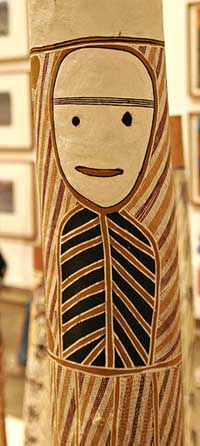
Indigenous Australian art (also known as Australian Aboriginal art) is art made by the Indigenous peoples of Australia and in collaborations between Indigenous and Non-Indigenous Australians . It includes works in a wide range of media including painting on leaves, wood carving, rock carving, sculpture, ceremonial clothing and sandpainting. This article discusses works that pre-date European colonization as well as contemporary art by Aboriginal Australians based on traditional culture. These have been studied in recent millenia and have gained increased international recognition.
Traditional Indigenous Art
Aboriginal rock art has been created for a long period of time, with the oldest examples, in West Australia's Pilbara region, and the Olary district of South Australia, estimated to be up to around 40,000 years old. Rock art gives us descriptive information about social activities, material culture, economy, environmental change, myth and religion. This is an Aboriginal way of showing recognition and wisdom-to be open to the environment.
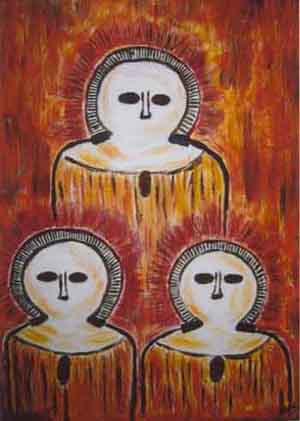
Australian Petroglyphs and Rock Art
Bark Painting
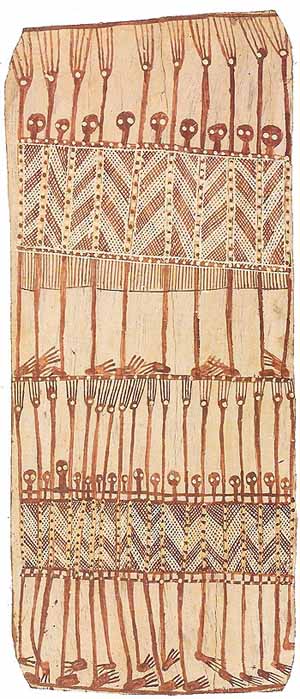
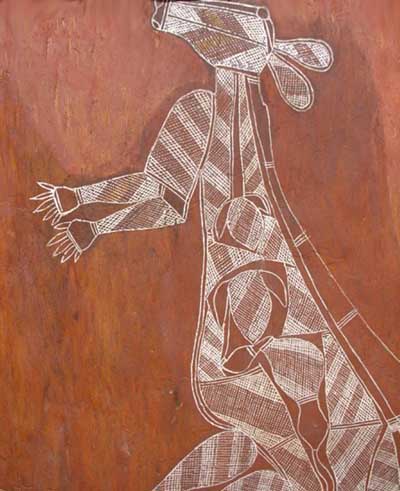
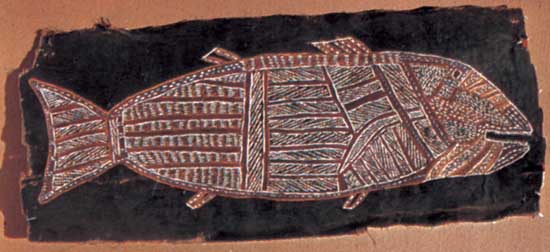
Bark painting is an Australian Aboriginal art form, involving painting on the interior of a strip of tree bark. This is a continuing form of artistic expression in Arnhem Land and other regions in the Top End of Australia including parts of the Kimberley region of Western Australia. Traditionally, bark paintings were produced for instructional and ceremonial purposes and were transient objects. Today, they are keenly sought after by collectors and public arts institutions.
The designs seen on authentic bark paintings are traditional designs that are owned by the artist, or his "skin", or his clan, and cannot be painted by other artists. In many cases these designs would traditionally be used to paint the body for ceremonies or rituals, and also to decorate logs used in burials ceremonies. While the designs themselves are ancient, the medium of painting them on a piece of flattened bark is a relatively modern phenomenon, although there is some evidence that artists would paint designs on the bark walls and roofs of their shelters.
The modern form of bark painting first appeared in the 1930s, when missionaries at Yirrkala and Milingimbi asked the local Yolngu people to produce bark paintings that could be sold in the cities of New South Wales and Victoria. The motives of the missionaries were to earn money that that would help pay for the mission, and also to educate white Australians about Yolngu culture (Morphy 1991). As the trade grew, and the demand for paintings increased, leading artists such as Narritjin Maymuru started being asked to mount exhibitions.
It was, however, not until the 1980s that bark paintings started being regarded as fine art, as opposed to an interesting Indigenous handicraft, and commanded high prices accordingly on the international art markets. Nowadays, the value of a fine bark painting depends not only on the skill and fame of the artist, and on the quality of the art itself, but also on the degree to which the artwork encapsulates the culture by telling a traditional story.
The barest necessities for bark artwork are paint, brushes, bark, fixative and a fire. The material of choice is the bark from Stringybark (Eucalyptus tetradonta). The bark must be free of knots and other blemishes. It is best cut from the tree in the wet season when the sap is rising. Two horizontal slices and a single vertical slice are made into the tree, and the bark is carefully peeled off with the aid of a sharpened tool. Only the inner smooth bark is kept and placed in a fire. After heating in the fire, the bark is flattened under foot and weighted with stones or logs to dry flat. Once dry, it is ready to paint upon.
Earth pigments - or ochres - in red, yellow and black are used, also mineral oxides of iron and manganese and white pipeclay, or calcium carbonate. Ochres may be fixed with a binder such as PVA glue, or previously, with the sap or juice of plants such as orchid bulbs.
After the painting is completed, the bark is splinted at either end to keep the painting flat. A fixative, traditionally orchid juice, is added over the top.
Bark paintings are based on sacred designs that include abstract patterns and designs (such as cross-hatching in particular colors) that identify a clan, and also often contain elements of the Eternal Dreamtime. Sometimes the elements of a story are obvious - such as men or animals - but sometimes the elements are symbolic. What appears to the tourist as a series of wavy lines punctuated by dots may actually be telling a complex Dreaming story describing the path of a creator spirit and events that happened along the way.
An uninitiated man or woman is only allowed to paint outside stories, the sort of story that might be told to a child. An initiated man can paint an inside story, which is restricted knowledge. Thus, a painting may be displayed in an exhibition, or put up for sale, but the artist, although having the right to paint the story, does not have the right to tell the story to another person. Alternatively, the story behind the painting may be one that may not be told to an uninitiated person. As buyers often want a story to go with the painting, this puts the artist in an unenviable position. The buyer may therefore receive a watered-down or distorted version of the story.
Most of the following is based on Morphy (1991), where far more detail may be found, and refers specifically to the Yolngu paintings from Yirrkala, although the same principles generally apply elsewhere.
Non-indigenous people who, like Morphy, have spent years studying the subject, still have an outsider's view and rely analogies. The Yolngu language and culture has words and concepts that are unfamiliar to non-indigenous cultures, which makes understanding the art form difficult. The following explanation only describes the physical aspects.
A bark painting consists of several components, not all of which may be present in an individual painting, and that are generally applied in the following order:
-
Ground
Border
Dividing Lines
Feature Blocks
Figurative designs
Geometric designs
Clan designs
Cross-hatching
Figurative designs resemble a real (or mythological) object or being. Thus, a figurative design of a possum Òlooks likeÓ a possum, as opposed to being an abstract symbol for a possum, which is recognizable only to someone familiar with this symbolism. Most commercially available bark paintings contain recognizable figurative designs that often tells a traditional story.
Geometric designs are representational symbols, and their meaning often depends on context and on who painted the painting. The same symbol can also have different meanings. For example, a circle might represent a water hole, a campsite, a mat, a campfire, a nut, an egg, a hole left by maggots, etc., depending on context. Yolngu culture takes a holistic view of the world, in which these meanings may not be so very different after all. Morphy gives the example of a circle and a line, which a non-initiate is told represents a kangaroo water hole, and depicts a water hole with a creek running into it. At a later ceremony, when he says he knows itÕs a Òkangaroo water holeÓ, he is told That water hole was made by the old man kangaroo digging in the ground with his tail to make a well for water, using his tail as a digging stick. Later, he is told an even more complex story involving a female kangaroo.
Unlike the previous components of the painting, Clan designs are sacred and initially did not appear on public paintings, although nowadays they can be seen on commercial paintings. A clan design may consist of a combination of symbols, geometric designs, and cross hatching, One clan symbol, for example, consists of a series of interlocking diamonds painted in particular colors, whilst another includes symbols of a sugar-bag (wild honey). A Yolngu person can immediately identify the clan and moiety of the painter from that design, which then also provides further context for interpreting the symbolism of the geometric designs.
Cross-hatching is perhaps one of the most distinctive and beautiful features of Yolngu art. Closely spaced fine lines are drawn in particular colours, intersecting each other. The chosen colours may be a specific to a particular clan, and the effect is difficult to describe, but produces a deep impression on the viewer. Traditionally, the most sacred designs drawn on bodies during ceremonies were drawn with a quality called bir'yun, which is loosely translated as scintillation (as in the twinkling of stars) but carries a connotation of sunlight reflected off sparkling water. Such designs were often deliberately smeared before they could be seen by women or non-initiates, because of the power imparted, which would be dangerous for someone who was not able to handle it.
The content depicted by the painting is often either a traditional Dreaming story or a map. Sometimes it will be both, because the ancestral stories and songs often refer to the paths of creation ancestors as they travel across the land. Morphy gives an example of a painting that depicts a particular ancestral journey, but also shows where an airstrip was built.
Australian Aboriginal Fibrecraft
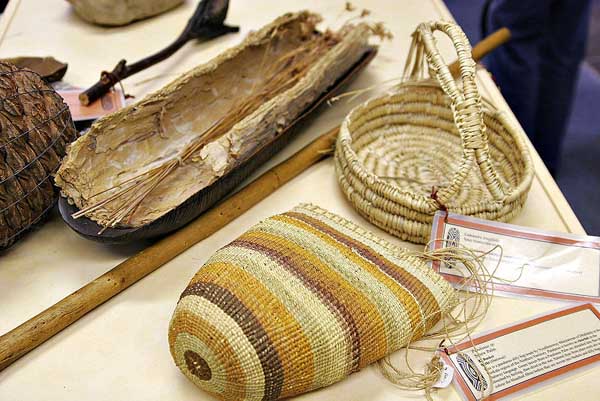
Australian Aboriginal fibrecraft refers to the various ways Australian Aborigines created fibers traditionally. Materials used depended on where the people lived in Australia. Bark was used by many people across the continent. This technology is still used today to produce baskets, which are particularly popular in the tourism industry. Kurrajong bark is a popular bark, as is the bark of river wattles, sand figs, banyans, burney vines and peanut trees. In the north, the more tightly woven styles were made, whereas in the south, a looser stringed bag, popularly known as a dilly bag was made.
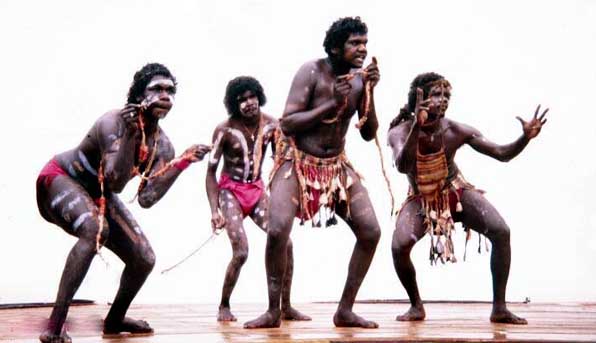
Hairstring was an important textile traditionally made by Australian Aborigines. People, particularly the women, cut their hair regularly using quartz or flint knives. This hair was never wasted. It was rolled on the thigh and then spun into long threads of yarn. It was then plaited to about the thickness of 8 ply wool. Purposes for the string were manifold. These included making the head ring for resting the coolamon, headbands to keep the hair off the face, spear-making (securing the head to the shaft), and even balls for ball games.
A general-purpose belt was made of the string, from which things could be hung, such as small game like goannas in order to free the hands on long walks and hunts.
Among some groups, including the Pitjantjajara, a small modesty apron was made of the string for young girls to wear when they reached puberty. People in Central Australia today may talk of a girl having her "string broken", which can mean sexual abuse, or having sex when she is not ready.
Among some tribes, adults wore a loincloth-like pubic covering, which also hung from the waist belt. This was made either of the string itself, or of other material, including paperbark. In the Kimberley region of Western Australia, the men wore pearl shells as a pubic covering, which they call Riji, and which are considered extremely sacred. The string could be dyed various shades using dyes such as ochre. Some string was only worn for ceremony, such as skirts worn by the women.
Many Aboriginal groups traditionally made many shapes out of the string (cat's cradle). A researcher once watched and photographed a young Aboriginal woman from Yirrkala make over 200 separate string figures. Each one involved complicated movements of her fingers and thumbs. She was able to remember the correct sequence of finger movements for nearly every figure she made, with only an occasional mistake which she quickly corrected. As she made each figure she gave it a name. Some examples included dangurang - a lobster, bapa - lightning, matjur - an ibis flying into a tree and gapu - the ripples on a pool.
The Bangarra Dance Theatre's 2005 production of CLAN incorporated traditional desert string games into one of their performances, creating intricate patterns as they thread themselves through long, elastic strings.
Grasses were combined with the hair to create a tougher fibre. This varied depending on the area in Australia. In the arid areas, it was spinifex, whereas in the Top End, it was palms such as pandanus.
Pandanus and sand-palm are used in areas such as the Daly River region and Arnhem Land to weave carry baskets, dilly string bags, wall hangings, floor mats and fish-nets. The women of Peppimenarti and Oenpelli are famous for such weaving, however each community has their own distinct styles and techniques.
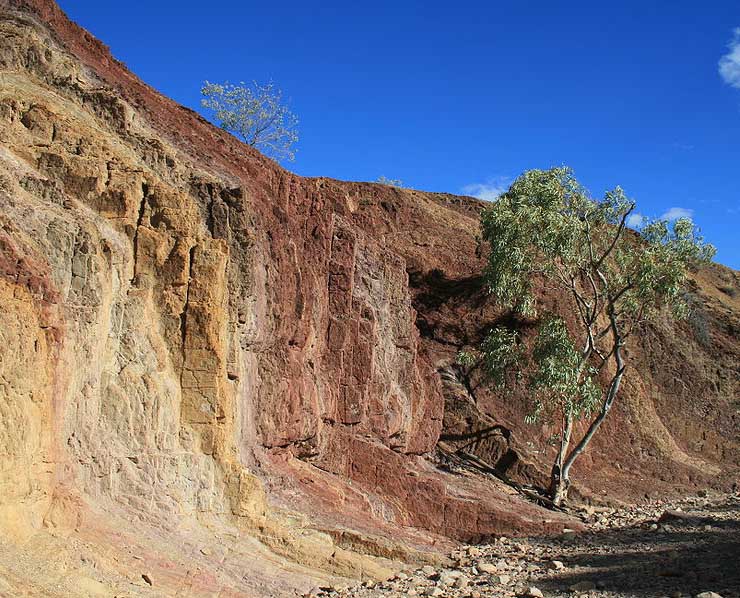
Iconography and Symbology
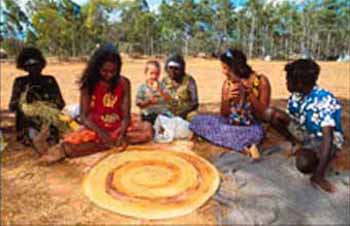
Spirals of Sacred Geometry
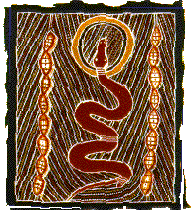
Snake - DNA - Twins
There were variations in the symbolic representation of some rock art and paintings, depending on the tribe or region of Australia that you belong to, which is still evident today in the modern art work of Aboriginal artists. The dotted motifs of much of today's Aboriginal modern design work has become the trademark of the contemporary Aboriginal Art movement. Its iconic status developed from a culture stretching back into the history of an ancient land, evolving and weaving into desert dreamtime stories.
Certain symbols within the Aboriginal modern art movement retain the same meaning across regions, although the meaning of the same symbols may change within the context of the whole painting. When viewed in monochrome other symbols can look similar, such as the circles within circles, sometimes depicted on their own, sparsely or in clustered groups. When this symbol is used and depending on the Aboriginal tribe you belong to, it can vary in meaning from campfire, tree, hill, digging hole, waterhole or spring. Use of the symbol can be clarified further by the use of color, such as water being depicted in blue or black.
Many paintings by Aboriginal artists, such as those that represent a 'dreamtime story', are shown from an aerial perspective. The narrative follows the lie of the land, as created by ancestral beings in their journey or during creation. The modern day rendition is a reinterpretation of songs, ceremonies, rock art and body art that was the norm for many thousands of years.
Whatever the meaning, interpretations of the icons should be taken in context of the entire painting, the region from which the artist originates, the story behind the painting, the style of the painting, with additional clues being the colors used in some of the more modern works, such as blue circles signifying water. (Source: Aboriginal Symbols - Indigenous Australia)
Religious and Cultural Aspects of Aboriginal Art
-
"Doesn't matter what sort of painting we do in this country, it still
belongs to the people, all the people. This is worship, work, culture.
It's all Dreaming. There are two ways of painting. Both ways are
important, because that's culture." - source The Weekend Australian
Magazine, April 2002
Tattoo
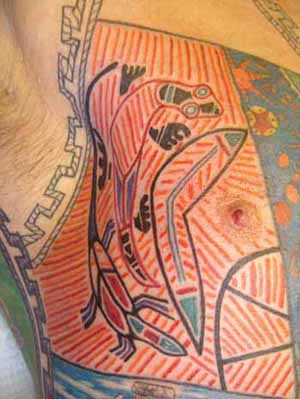
Barunga Art
Barunga Art
One of the best ways of deciphering what ancient art has to say about past cultural beliefs and social structures is to study art created by living peoples. Nowhere is that more effective than among the Aboriginal people of Australia, many of who did not encounter Europeans until well into the twentieth century.
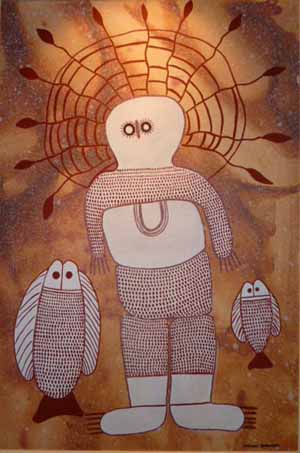
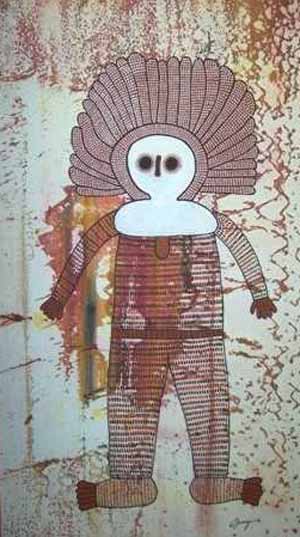
Aboriginal people, inheritors of one of the oldest living artistic traditions in the world, came to Australia about 50,000 years ago. They have given us some of the earliest examples of a developed artistic and aesthetic sense. Working with the Aboriginal people of the Barunga region of southern Arnhem Land, Australia, I set out to identify factors that influence the creation of art, asking specifically whether different social activities and materials produce different kinds of art.
Aboriginal artists in Barunga today emphasize designs that are believed to have their genesis in the actions of ancestral beings, which endow them with power. Aesthetic value is judged by how accurately the artist represents the dictates and stories of the ancestors. Most senior artists also have major roles in ceremonies, and many become important ritual leaders - the recognized custodians of ancestral knowledge.
Analyzing the impact of social conditions and available materials on their living art should illuminate for archaeologists the range of past artistic styles and the societies that produced it.
Within the Barunga artistic system, the inherent properties of the materials impose important constraints on artistic style. Rock art is the most significant example. Though rarely produced today, rock art remains an integral part of Aboriginal peoples' living traditions in this region.
Surprisingly, rock art is not representative of the overall artistic tradition. Rock is a distinctive base material with an unusually large, rough canvas that is generally vertical. This makes rock ideal for some types of figures and artistic techniques, such as scenes that depict many figures, but not others. For example, rock does not lend itself to an artistic technique like cross-hatching, which is easily produced on smooth, flat surfaces.
Moreover, rock is part of the landscape and, therefore, already rich in social identity. Information such as language group and clan need not be communicated in rock art Ü it has been part of the raw material since the Barunga creation era (The Dreaming). At that time, the "ancestral beings" traveled the land, creating topographic features and finally "sitting down" to become forever a part of a specific place. Every facet of the landscape thus is imbued with ancestral associations and social identity.
Barunga society is sharply divided into two complementary, descent-based branches (a structure anthropologists call "moiety"), which permeate relationships, spirituality, and many other aspects of life. Moiety is an important means by which Aboriginal people conceive of place.
During The Dreaming, the ancestral beings assigned everything - people, animals, plants, places - to a moiety, either Dhuwa or Yirritja. Each is associated with particular colors and proportions. Dhuwa is linked to shortness and dark colors, such as black and red; while Yirritja is tied to tallness and light colors, such as white and yellow. Thus, the black cockatoo and the short-necked turtle are Dhuwa, while the white cockatoo and long-necked turtle are Yirritja.
One of the most important principles of Barunga art is to join Dhuwa and Yirritja moieties so they are "in company." Nearly all art forms combine light and dark colors, regardless of the social identity of the artist or of the audience.
In rock art, moiety is encoded in the stone through the color of the rock and the moiety of the land. Thus, a rock painting can conform to the principle of joining Dhuwa and Yirritja even if the painting is made in a single color.
The clearest social influence on art is the gender of the artist. Women work mainly with fiber, while men emphasize wood and paint. Sharp, gender-based differences between art forms may be interpreted as a way of reflecting and reinforcing gender differences in Barunga society.
Art is a link to the ideological realm for male artists who depict totemic species and ancestral and mythological figures. This highly structured art is an affirmation that the artist is meeting his responsibilities to the ancestral world, actually maintaining it in some way. Aboriginal people say that men's art has "meaning." It communicates information about Dreaming stories and is tied to land and rights of inheritance.
Women's art, on the other hand, has neither this explicit spiritual dimension nor clear-cut links to land. It follows traditional rules of production but lacks the layers of meaning contained in men's paintings. Women describe their art as having "patterning" rather than meaning. However, this should not be taken to mean that women do not have religious power or knowledge. It is simply that this knowledge and authority has different material manifestations than those of men.
The gender difference is not absolute. Barunga people make it clear that men can make baskets or bags, and women can make painted or carved objects. Another important influence on artistic style is the intended audience. Art produced for ceremonies is stylistically much simpler than that produced for non-Aboriginal audiences.
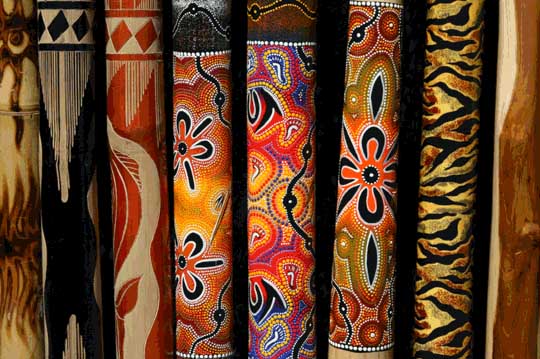
The striking example is the didgeridoo. Among the oldest musical instruments, it is about 1.2 meters (4 feet) long, made from a hollowed tree limb. It produces a complex, low-pitched humming sound. Though central to many Aboriginal ceremonies, didgeridoos also sell briskly to tourists Ü and the two versions are very different.
Didgeridoos for Aboriginal audiences are of simple, polished wood or they are painted in plain colors or in geometric bands of color. This rule is strictly adhered to, even if innovative materials are used in production. But didgeridoos created for sale to tourists are made "flash" through the use of cross-hatching and a wide range of figurative motifs.
So in some respects, there are two Barunga artistic systems: one highly decorated with variable designs for non-Aboriginal people and another with simpler and more restricted motifs.
Aboriginal artists produce work they judge to be marketable to outsiders, who typically want a memento bearing designs clearly identifiable as "Aboriginal." Plain, polished wood or simple bands of color do not serve this purpose.
Art produced in a ceremonial context for an Aboriginal audience usually is created in the company of other Aboriginal people, rather than by a single artist working alone. The presence of other people with religious authority reinforces the principle that art should follow the dictates of the ancestors and inhibits artistic innovation and stylistic diversity.
The dual forms suggest Barunga artists are protecting the private features of their culture, while at the same time exploiting the economic opportunities presented by the non-Aboriginal art market. Similar stylistic differences may well have existed long before tourists reached the outback. Certain art forms may have been designed only for particular culture groups, while others were allowed to see only less-spiritual variations.
The implications for archaeology are wider still. In Ancestral Connections, anthropologist Howard Morphy reports a similar dichotomy in the Aboriginal art of northeast Arnhem Land. Paired with the results of my study, this suggests a possible link in Australian Aboriginal societies between ceremonial contexts and geometric art (as opposed to designs based on figures).
The possibility can be tested ethnographically by studying contemporary Indigenous societies, and archaeologically by examining the art of both contemporary and past societies in other parts of the world. While specific social and material influences on Barunga art cannot automatically be applied to other societies, we should consider such factors when analyzing the art of past societies.
But caution is required: Human societies are wonderfully complex and diverse. Even a category as clearly defined as gender can find vastly different expressions. While researchers can identify links between material culture and human behavior in the present, earlier societies may have included social structures quite different from anything we are aware of today.
The most important implication of this work is to emphasize that different artistic styles can be produced by the same people in the same place at the same time. Styles can vary drastically according to the materials used and the social strategies being pursued. A single, all-encompassing explanation based on one art form will rarely suffice, since it most likely tells only part of the story.
Aboriginal Stone Arrangement
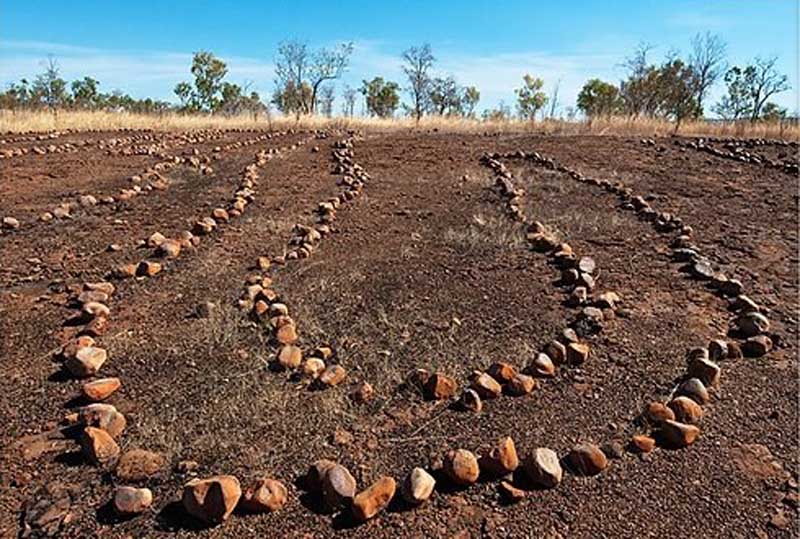
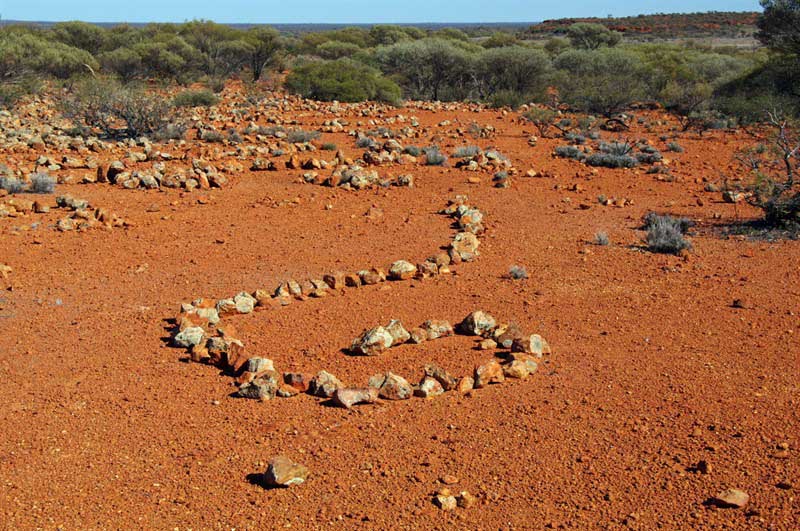
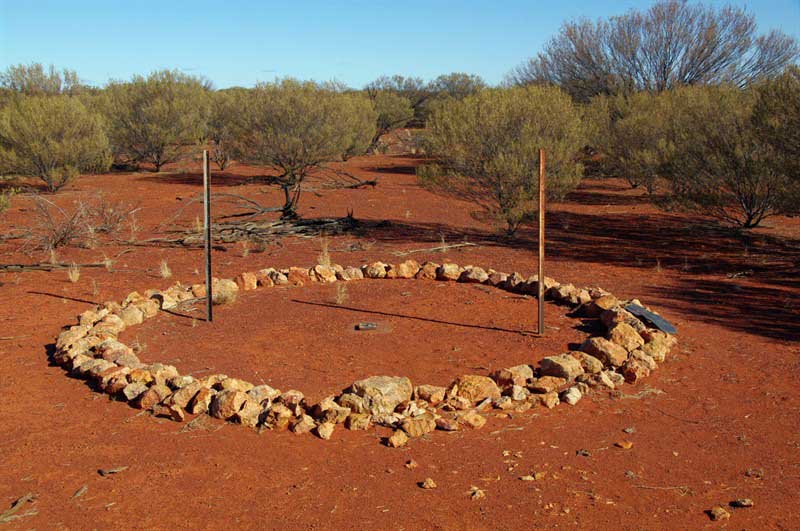
Aboriginal stone arrangements are a ritual art form constructed by Indigenous Australians, and are a form of rock art. Typically, they consist of stones, each of which may be about 30 cm in size, laid out in a pattern extending over several metres or tens of metres. They were made by many different Australian Aboriginal cultures,and in many case are thought to be associated with rituals.
Particularly fine examples are in Victoria, where the stones can be very large (up to 1 metre high). For example, the stone arrangement at Wurdi Youang consists of about 100 stones arranged in an egg-shaped oval about 50m across. Each stone is well-embedded into the soil, and many have "trigger-stones' to support them.
The appearance of the site is very similar to that of the megalithic stone circles found throughout Britain (although the function and culture are presumably completely different). Although its association with Indigenous Australians is well-authenticated and beyond doubt, the purpose is unclear, although it may have a connection with initiation rites. It has also been suggested that the site may have been used for astronomical purposes (Morieson 2003). Other well-known examples in Victoria include the stone arrangements at Carisbrook and Lake Bolac.
Australia's largest collection of standing stones is said to be at Murujuga, also known as the Burrup peninsula or the Dampier archipelago, in Western Australia, which includes tall standing stones similar to the European menhirs, as well as circular stone arrangements.
A very different example is found near Yirrkala in Arnhem Land, where there are detailed images of the praus used by Macassan fisherman fishing for Trepang, several hundred years before European contact. Here the stones are small (typically 10Ð20 cm), sit on the surface of the ground, and can easily be moved by hand, which also implies that they can be easily damaged or altered by modern hands, so that caution is needed when interpreting such sites.
Similar examples are found scattered throughout Australia, mainly in remote or inaccessible places, and it is likely that there were many more prior to European settlement of Australia.
In South East Australia are found Bora rings which consist of two circles of stones, one larger than the other, which were used in an initiation ceremony and rite of passage in which boys were transformed into men.
Contemporary Indigenous Australian Art
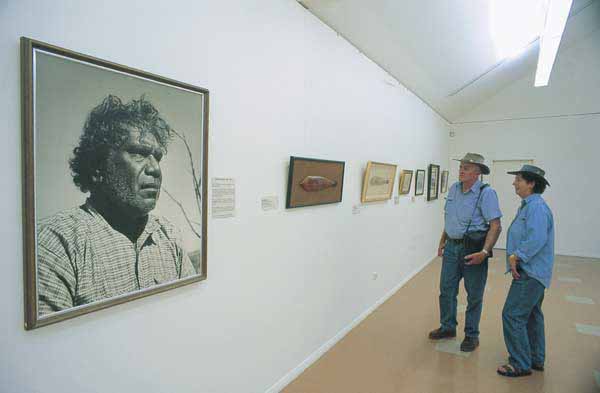
Contemporary Indigenous Australian art is the modern art work produced by Indigenous Australians. It is generally regarded as beginning with a painting movement that started at Papunya, northwest of Alice Springs, Northern Territory in 1971, involving artists such as Clifford Possum Tjapaltjarri and Kaapa Tjampitjinpa, and facilitated by white Australian teacher and art worker Geoffrey Bardon. The movement spawned widespread interest across rural and remote Aboriginal Australia in creating art, while contemporary Indigenous art of a different nature also emerged in urban centres; together they have become central to Australian art.
Leading Indigenous artists have had solo exhibitions at Australian and international galleries, while their work has been included in major collaborations such as the design of the Musee du quai Branly. Contemporary Indigenous artists have won many of Australia's most prominent art prizes: the Wynne Prize has been won by Indigenous artists on at least three occasions; Shirley Purdie won the religious-themed Blake Prize in 2007 with Linda Syddick Napaltjarri a finalist on three occasions. Indigenous artists, including Rover Thomas, have represented Australia at the Venice Biennale in 1990 and 1997.
In 2007, a painting by Emily Kngwarreye, Earth's Creation, was the first Indigenous art work to sell for more than $1 million. Works by contemporary Indigenous artists are held by all of Australia's major public galleries, including the National Gallery of Australia, which in October 2010 opened a new wing dedicated to its Indigenous collection.
Indigenous Australian art can claim to be "the worldÕs longest continuing art tradition". Prior to European settlement of Australia, Indigenous people used many art forms, including sculpture, wood carving, rock carving, body painting, bark painting and weaving. Many of these continue to be used both for traditional purposes and in the creation of art works for exhibition and sale. Some other techniques have declined or disappeared since European settlement, including body decoration by scarring and the making of possum-skin cloaks. However, Indigenous Australians also adopted and expanded the use of new techniques including painting on paper and canvas. Early examples include the late nineteenth century drawings by William Barak.
In the 1930s, artists Rex Battarbee and John Gardner introduced watercolour painting to Albert Namatjira, an Indigenous man at Hermannsberg Mission, south-west of Alice Springs. His landscape paintings, first created in 1936 and exhibited in Australian cities in 1938, were immediately successful, and he became the first Indigenous Australian watercolorist as well as the first to successfully exhibit and sell his works to the non-Indigenous community. Namatjira's style of work was adopted by other Indigenous artists in the region beginning with his close male relatives, and they became known as the Hermannsburg School or as the Arrernte Watercolourists.
Namatjira died in 1959, and by then a second initiative had also begun. At Ernabella, now Pukatja, South Australia, the use of bright acrylic paints to produce designs for posters and postcards was introduced. This led later to fabric design and batik work, which is still produced at Australia's oldest Indigenous art centre.
At the same time, Kaapa Tjampitjinpa, a member of the community who worked with Bardon, won a regional art award at Alice Springs. Soon over 20 men at Papunya were painting, and they established their own company, Papunya Tula Artists Limited, to support the creation and marketing of works.
Although painting took hold quickly at Papunya, it remained a "small-scale regional phenomenon" throughout the 1970s, and for a decade none of the state galleries or the national gallery collected the works. However, the painting movement developed rapidly in the 1980s, spreading to Yuendumu, Lajamanu, Utopia and Haasts Bluff in the Northern Territory, and Balgo, Western Australia.
By the 1990s artistic activity had spread to many communities throughout northern Australia, including those established as part of the Outstation movement, such as Kintore, Northern Territory and Kiwirrkurra Community, Western Australia. Since then, expansion has continued, with at least 10 painting communities developing in central Australia between the late 1990s and 2006.
Indigenous art cooperatives have been central to the emergence of contemporary Indigenous art. Whereas many western artists pursue formal training and work as individuals, most contemporary Indigenous art is created in community groups and art centres.
In 2010, the peak body representing central Australian Indigenous art centres, Desart, had 44 member centres, while the Association of Northern, Kimberley and Arnhem Aboriginal Artists (ANKAAA), the peak body for northern Australian communities, had 43 member centres. The centres represent large numbers of artists - ANKAAA estimates its member organisations alone include up to 5000 artists.
Styles and Themes
Indigenous artists from remote central Australia, particularly the central and western desert area, frequently paint particular 'dreamings', or stories, for which they have personal responsibility or rights. Best known amongst these are the works of the Papunya Tula painters and of Utopia artist Emily Kngwarreye. The patterns portrayed by central Australian artists, such as those from Papunya, originated as translations of traditional motifs marked out in sand, boards or incised into rock. The symbols used in designs may represent place, movement, or people and animals, while dot fields may indicate a range of phenomena such as sparks, clouds or rain.
In Arnhem Land in the Northern Territory, men have painted their traditional clan designs. The iconography however is quite separate and distinct from that of central Australia. In north Queensland and the Torres Strait many communities continue to practice cultural artistic traditions along with voicing strong political and social messages in their work.
In Indigenous communities across northern Australia most artists have no formal training, their work being based instead on traditional knowledge and skills. In southeast Australia other Indigenous artists, often living in the cities, have trained in art schools and universities. These artists are sometimes referred to as 'urban' Indigenous artists, although the term is sometimes controversial, and does not accurately describe the origins of some of these individuals, such as Bronwyn Bancroft who grew up in the town of Tenterfield, New South Wales, Michael Riley who came from rural New South Wales near Dubbo and Moree, or Lin Onus who spent time on his father's traditional country on the Murray River near Victoria's Barmah forest. Some, like Onus, were self-taught while others, such as artist Danie Mellor or artist and curator Brenda Croft, completed university studies in fine arts.
Media
Textile production including batik has been important in the northwestern desert regions of South Australia, in the Northern Territory's Utopia community, and in other areas of central Australia. For a decade before commencing the painting career that would make her famous, Emily Kngwarreye was creating batik designs that revealed her "prodigious original talent" and the modernity of her artistic vision.[37] A wide range of textile art techniques, including dyeing and weaving, is particularly associated with Pukatja, South Australia (formerly known as Ernabella), but in the mid 2000s the community also developed a reputation for fine sgraffito ceramics. Hermannsburg, originally home to Albert Namatjira and the Arrente Watercolourists, is now renowned for its pottery.
Amongst 'urban' Indigenous artists, more diverse techniques are in use such as silkscreen printing, poster making, photography, television and film. One of the most important contemporary Indigenous artists of his generation, Michael Riley worked in film, video, still photography and digital media. Likewise, Bronwyn Bancroft has worked in fabric, textiles, "jewellery design, painting, collage, illustration, sculpture and interior decoration".
Nevertheless, painting remains a medium used by many 'urban' artists, such as Gordon Bennett, Fiona Foley, Trevor Nickolls, Lin Onus, Judy Watson, and Harry Wedge.
Assessment
Modern Indigenous art has been described by leading critic Robert Hughes as "the last great art movement of the 20th century", and by poet Les Murray as "Australia's equivalent of jazz".
Paintings by the artists of the western desert in particular have quickly achieved "an extraordinarily widespread reputation", with collectors competing to obtain them. Some Indigenous artists are regarded as amongst the foremost Australian painters; Emily Kngwarreye has been described as "one of the greatest modern Australian painters", and "among the best Australian artists, arguably amongst the best of her time." Critics reviewing the Hermitage Museum exhibition in 2000 were universal in their praise, one remarking: "This is an exhibition of contemporary art, not in the sense that it was done recently, but in that it is cased in the mentality, technology and philosophy of radical art of the most recent times. No one, other than the Aborigines of Australia, has succeeded in exhibiting such art at the Hermitage".
Not all of the assessments have been universally favourable. Museum curator Philip Batty, who had been involved in assisting the creation and sale of art works in central Australia, expressed concern at the effect of the non-Indigenous art market on the artists Ð particularly Emily Kngwarreye Ð and their work. He wrote "there was always a danger that the European component of this cross-cultural partnership would become overly dominant. By the end of her brief career, I think that Emily had all but evacuated this intercultural domain, and her work simply became a mirror image of European desires". Outstanding art works are mixed with poor ones, with the passage of time yet to filter the good from the bad.
The contemporary Indigenous art movement has influenced many non-Indigenous Australian artists, particularly through collaborative projects. Indigenous artists Gordon Bennett and Michael Nelson Jagamarra, have engaged in both collaborative artworks and exhibitions with gallerist Michael Eather, and painter Imants Tillers, the Australian-born son of Latvian refugees. The Australian Research Council and Land & Water Australia supported an artistic and archaeological collaboration through the project "Strata: Deserts Past, Present and Future", which involved Indigenous artists Daisy Jugadai Napaltjarri and Molly Jugadai Napaltjarri.
UFOs in Australia
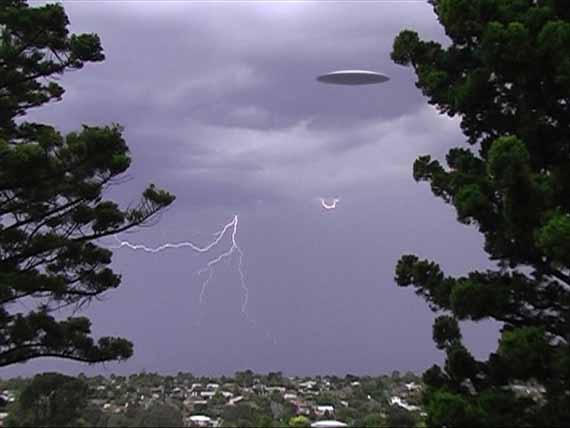
As depicted in the art and petroglyphs of the Aboriginal people, UFO and alien sightings go back to ancient times. Although there have been UFO sightings all over Australia, some of the most frequent sightings have been in New South Wales, near Katoomba - the chief town of the City of Blue Mountains in New South Wales, Australia.
Following global patterns, sightings are more common in specific grid points and ley lines where the magnetics are strongest. Locals in these areas often have sightings that are not reported to the government or the media. There are few indigenous people who have not seen UFOs and consider them part of their legends and ancient mythologies, highlighted in their creation myths. Gods visit in flying spacecraft and create a race called humans. There is always the promise they will return one day. As with the rest of the world, UFO sightings are increasing as if to some final destiny many anticipate. It's all going somewhere ... soon.
Several Case Studies
At approximately 11.00 am on Wednesday, 6 April 1966, a class of students and a teacher from Westall High School (now Westall Secondary College) were just completing sports on the main oval when an object, described as being a grey saucer-shaped craft with a slight purple hue and being about twice the size of a family car, was alleged to have been seen. Witness descriptions were mixed: Andrew Greenwood, a science teacher, told The Dandenong Journal at the time that he saw a silvery-green disc.
According to witnesses the object was descending and then crossed and overflew the high school's south-west corner, going in a south-easterly direction, before disappearing from sight as it descended behind a stand of trees and into a paddock at The Grange in front of the Westall State School (primary students). After a short period (approximately 20 minutes) the object - with witnesses now numbering over 200 - then climbed at speed and departed towards the north-west. As the object gained altitude some accounts describe it as having been pursued from the scene by five unidentified aircraft which circled the object.
The alleged sighting was investigated by two groups: The Victorian Flying Saucer Research Society (VFSRS) and Phenomena Research Australia (PRA). Both groups described it as being one of Australia's major unexplained UFO cases. The VFSRS team arrived on the site on 8 April and spoke to students and viewed the ground mark. The VFSRS printed an image and a small report in their magazine "Australian UFO Bulletin" in December 2000. An investigator, Brian Boyle (PRA), arrived at the site on 9 April with four army investigators. Boyle did a number of interviews, which he recorded on tape, over a number of days and took samples from the ground mark. These investigators were able to speak to many of the witnesses as it was over the Easter holidays - April 8-11.
Though some witnesses reported five Cessna-type aircraft around the object, investigators were unable to find any record of such aircraft. Moorabbin Airport, which is 4.76 km (south-west) from the location, was checked but no aircraft from that airport entered the airspace. The RAAF also reported no military activity in that area. The Australian Skeptics described the object as potentially having been an experimental military aircraft. They suggest that it may have been a nylon target drogue, like a wind sock, towed by one plane for the others to chase and known to be in use by the local RAAF at the time
One of the most famous cases occurred in 1972 on the Bernard Eddelbuttel farm. As Mrs. Eddelbuttel was washing dishes one night she saw an orange light moving above the trees and descending west of the house behind some pig sheds. Thinking the lights came from spotlight hunters who shoot game when it is blinded by light, she called her husband who was in the bathtub to come and investigate.
Meanwhile a brother-in-law went to the pig sheds to investigate. What he saw seized him with panic and he ran back to the farmhouse to tell the others. There was a disk-shaped craft hovering amid the trees with a light so bright it lit up the whole area. The blinding light came from a central dome, but there were other lights around it. As he watched, the glow faded rapidly, leaving the craft almost invisible in the darkness among the trees.
The family locked and bolted every door and called the police. Meanwhile motorists on a nearby freeway had seen the light and were also calling to report it. At first the police were reluctant to investigate and it took several calls to get them to drive out to the farm. When they arrived, all traces of the UFO were gone. Others also reported seeing the object at close range.
In another report in 1973 Jason Bentley sighted a strange object at 8 pm, passing over nearby Kanimbla Valley (not far from Bathurst), heading from east to west. The valley was covered in a layer of mist and the object, which was lit by bright yellow lights reflected off the mist, as it traveled at great speed. Within the next half hour others also reported seeing the UFO.
The Valentich disappearance refers to the unexplained disappearance on 21 October 1978 of 20-year-old Frederick Valentich while piloting a Cessna 182L light aircraft over Bass Strait in Australia. He intended to land at King Island to pick up three or four friends and return to Moorabbin Airport.
During the 127-mile (235 km) flight, Valentich advised Melbourne air traffic control that he was being accompanied by an aircraft about 1,000 feet (300 m) above him. He described some unusual actions and features of the aircraft, saying that his engine had begun running roughly, and finally reported that the "strange aircraft is hovering on top of me again. It is hovering and it's not an aircraft."
Valentich and his aircraft were never found, and an Australian Department of Transport investigation concluded that the reason for the disappearance could not be determined.
Belated reports of a UFO sighting in Australia on the night of the disappearance led Ken Williams, a spokesman for the Department of Transport, to tell Associated Press that "it's funny all these people ringing up with UFO reports well after Valentich's disappearance."
A pilot with a Class Four instrument rating and 150 hours of flight experience, Valentich filed a flight plan from Moorabbin Airport, Melbourne, to King Island in Bass Strait on 21 October 1978. Visibility was good and winds were light. He was flying a Cessna 182-L, with a cruising speed of around 256 km/h (160 mph). He departed Moorabbin at 18:19 local time, contacted the Melbourne Flight Service Unit to inform them of his presence, and reported reaching Cape Otway at 19:00.
At 19:06, Valentich asked Melbourne Flight Service Officer Steve Robey for information on other aircraft at his altitude (below 5000 ft, 1524 m) and was told there was no known traffic at that level. Valentich said he could see a large unknown aircraft which appeared to be illuminated by four bright landing lights. He was unable to confirm its type, but said it had passed about 1,000 feet (300 m) overhead and was moving at high speed. Valentich then reported that the aircraft was approaching him from the east and said the other pilot might be purposely toying with him
At 19:09 Robey asked Valentich to confirm his altitude and that he was unable to identify the aircraft. Valentich confirmed his altitude and began to describe the aircraft, saying that it was "long", but that it was traveling too fast for him to describe it in more detail. Valentich stopped transmitting for about 30 seconds, during which time Robey asked for an estimate of the aircraft's size. Valentich replied that the aircraft was "orbiting" above him and that it had a shiny metal surface and a green light on it. This was followed by 28 seconds silence before Valentich reported that the aircraft had vanished. There was a further 25-second break in communications before Valentich reported that it was now approaching from the southwest.
Twenty-nine seconds later, at 19:12:09 Valentich reported that he was experiencing engine problems and was going to proceed to King Island. There was brief silence until he said "it is hovering and it's not an aircraft". This was followed by 17 seconds of unidentified noise, described as being "metallic, scraping sounds", then all contact was lost.
A Search and Rescue alert was given at 19:12. Valentich failed to arrive at King Island by 19:33, and a sea and air search was undertaken, and two RAAF P-3 Orion aircraft searched over a seven-day period. Search efforts continued until 25 October 1978. Analysis of a fuel slick found roughly near where Valentich had last radioed Robey proved that it was not aviation fuel, and no trace of the aircraft was found. The aircraft was equipped with four life jackets and an emergency radio beacon, and was designed to stay afloat for several minutes.
A two-week long Department of Transport (DOT) investigation into Valentich's disappearance was unable to determine the cause, but that it was "presumed fatal" for Valentich. A report published on 27 April 1982, summarized the radio conversations on the evening of 21 October 1978 between Valentich and Robey.
During Valentich's final recorded transmission to the Melbourne Service Unit, seventeen seconds of unexplained noise, described as being "metallic, scraping sounds," were recorded by DOT Air Traffic Control audio tapes. The tape of the conversation ending with this noise was never made public. Only researchers and the parents of Valentich heard the transmission recordings.
Researchers Paul Norman and John W. Auchettl received a full copy of the original voice tapes from the DOT and later from the pilotÕs father for analysis. Auchettl had a copy analysed by the Royal Melbourne Institute of Technology (RMIT) and another was taken to the United States by Norman for analysis by Dr. Richard F. Haines, a former researcher with NASA-Ames and Associate Professor of Psychology at San Jose State University.
Haines described the sounds as "Thirty-six separate bursts with fairly constant start and stop pulses bounding each one," and said that there were "no discernible patterns in time or frequency." The significance of the sounds, if any, has remained undetermined.
After news of Valentich's disappearance became public, a number of individuals reported witnessing unusual activity in the area.Some people claimed to have seen "an erratically moving green light in the sky" and in one instance witnesses, located about 2 km west of Apollo Bay, Victoria, stated that they saw a green light trailing or shadowing Valentich's plane, and that he was in a steep dive at the time. Ufologists said these accounts were significant as most were recorded several years prior to the 1982 release of transcripts in which Valentich had described the object above him as having a green light.
According to an Associated Press report, Guido Valentich, the father of the missing pilot, said "he hoped his son had been taken by a UFO and had not crashed. 'The fact that they have found no trace of him presents a possibility that UFOs could have been there.'"; Guido Valentich also told the AP that "his son used to study UFOs as a hobby using information he had obtained from the air force. He was not the kind of person who would make up stories. Everything had to be very correct and positive for him.'"
Unconventional explanations for Valentich's disappearance include speculation by ufologists that the unexplained aircraft with the green light that he reported was an extraterrestrial vehicle, which in turn either abducted Valentich or caused the destruction of his plane in some fashion.
Speculation that a UFO was involved has been fueled by a number of factors, including Valentich's last transmission, in which he described the aircraft shadowing him as hovering and not an aircraft, the unexplained sounds that were heard at the end of his transmission, and a rash of UFO reports from the area.
Koala Bears

The koala (Phascolarctos cinereus) is an arboreal herbivorous marsupial native to Australia, and the only extant representative of the family Phascolarctidae.
The koala is found in coastal regions of eastern and southern Australia, from near Adelaide to the southern part of Cape York Peninsula. Populations also extend for considerable distances inland in regions with enough moisture to support suitable woodlands. The koalas of South Australia were largely exterminated during the early part of the 20th century, but the state has since been repopulated with Victorian stock. The koala is not found in Tasmania or Western Australia.
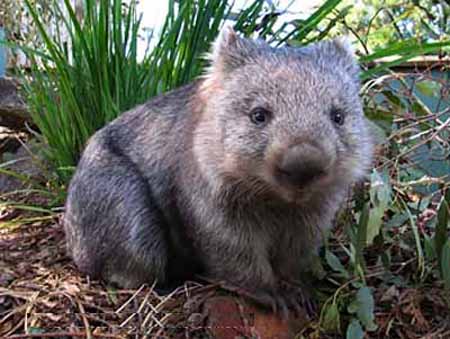
The origins of the koala are unclear, although almost certainly they descended from terrestrial wombat-like animals. Koala fossils are quite rare, but some have been found in northern Australia dating to 20 million years ago. During this time, the northern half of Australia was rainforest. The koala did not specialize in a diet of eucalyptus until the climate cooled and eucalypt forests grew in the place of rainforests. The fossil record indicates that before 50,000 years ago, giant koalas inhabited the southern regions of Australia. The koala fills the same ecological role as the sloth of South America.
The word koala comes from the Dharuk gula. Although the vowel /u/ was originally written in the Latin alphabet as "oo" (in spellings such as coola or koolah), it was changed to "oa" possibly due to an error. The word is erroneously said to mean "doesn't drink".
The scientific name of the koala's genus, Phascolarctos, is derived from Greek phaskolos "pouch" and arktos "bear". Its species name, cinereus, is Latin and means "ash-colored".
Although the koala is not a bear, English-speaking settlers from the late 18th century first called it koala bear due to its similarity in appearance to bears. Although taxonomically incorrect, the name koala bear is still in use today outside Australia - its use is discouraged because of the inaccuracy in the name. Other descriptive English names based on "bear" have included monkey bear, native bear, and tree-bear.
Although three subspecies have been described, these are arbitrary selections from a cline and are not generally accepted as valid. Following Bergmann's Rule, southern individuals from the cooler climates are larger.
A typical Victorian koala (formerly P. cinereus victor) has longer, thicker fur, is a darker, softer grey, often with chocolate-brown highlights on the back and forearms, and has a more prominently light-colored ventral side and fluffy white ear tufts.
Typical and New South Wales koala weights are 12 kg (26 lb) for males and 8.5 kg (19 lb) for females. In tropical and sub-tropical Queensland, however, the koala is smaller (at around 6.5 kg (14 lb) for an average male and just over 5 kg (11 lb) for an average female), a lighter often rather scruffy grey in color, and has shorter, thinner fur.
In Queensland, the koala was previously classified as the subspecies P. cinereus adustus, and the intermediate forms in New South Wales as P. cinereus cinereus.
A fourth variation, though not technically a subspecies, is Phascolarctos cinereus aurum, or in English "golden koala," which has a slight golden tinge to the fur as a result of an absence of the melanin pigment that produces albinism in most other mammalian species.
The variation from one form to another is continuous and there are substantial differences between individual koalas in any given region such as hair color.
The koala is broadly similar in appearance to the wombat (its closest living relative), but has a thicker coat, much larger ears, and longer limbs. The koala has large, sharp claws to assist with climbing tree trunks.
Weight varies from about 14 kg (31 lb) for a large southern male, to about 5 kg (11 lb) for a small northern female. The koala's five fingers include two opposable thumbs, providing better gripping ability. The first two fingers are positioned in apposition on the front paws, and the first three fingers for the hind paws.
The koala is one of the few mammals (other than primates) that has fingerprints. Koala fingerprints are similar to human fingerprints; even with an electron microscope, it can be quite difficult to distinguish between the two.
The teeth of the koala are adapted to their herbivorous diet, and are similar to those of other diprotodont marsupials, such as kangaroos and wombats. They have sharp incisors to clip leaves at the front of the mouth, separated from the grinding cheek teeth by a wide diastema.
The male koala, like many marsupials, has a bifurcated penis. The female has two lateral vaginas and two separate uteri, which is common to all marsupials.
The brain in the ancestors of the modern koala once filled the whole cranial cavity, but has become drastically reduced in the present species, a degeneration scientists suspect is an adaptation to a diet low in energy.
One of the smallest in marsupials with no more than 0.2% of its body weight, about 40% of the cranial cavity is filled with cerebrospinal fluid, while the brain's two cerebral hemispheres are like "a pair of shriveled walnut halves on top of the brain stem, in contact neither with each other nor the bones of the skull. It is the only animal on Earth with such a strangely reduced brain."
It is generally a silent animal, but males have a very loud advertising call that can be heard from almost a kilometre away during the breeding season. When under stress, koalas may issue a loud cry, which has been reported as similar to that of a human baby. There is little reliable information about the lifespan of the koala, but in captivity they have been observed to reach the age of 18 years.
joey clinging to the back.
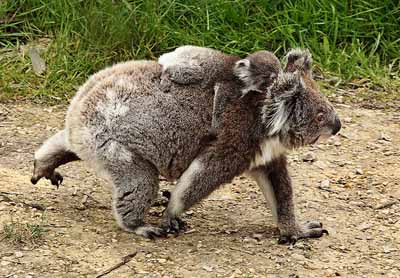
A baby koala is referred to as a joey and is hairless, blind, and earless. At birth the joey, only a quarter of an inch long, crawls into the downward-facing pouch on the mother's belly (which is closed by a drawstring-like muscle that the mother can tighten at will) and attaches itself to one of the two teats.
Young remain hidden in the pouch for about six months, only feeding on milk. During this time they grow ears, eyes, and fur. The joey then begins to explore outside of the pouch. At about this stage it begins to consume small quantities of the motherÕs "pap" (formerly thought to be excrement, but now thought to come from the mother's cecum) in order to inoculate its gut with the microbes necessary to digest eucalypt leaves.
The joey will remain with its mother for another six months or so, riding on her back, and feeding on both milk and eucalypt leaves until weaning is complete at about 12 months of age. Young females disperse to nearby areas at that time; young males often stay in the mother's home range until they are two or three years old.
In 1990 a group of high school boys hiking in the Jameison Valley reported being buzzed by silver, spherical ball with small spike projections about 40 centimeters in width. It made fast, erratic movements above them, then hovered nine feet above the track ahead of them before shooting off over the trees. This area has often been the site of UFO encounters.
In 1977 a group of seven young men on a camping trip heard a loud, throbbing noise that seemed to be coming from the earth beneath them. As it increased the earth seemed to vibrate and the boys tried to find its source. Failing that, they tried to sleep, but the throbbing continued most of the night. The next day they could find no explanation for the noise or vibration.
Australian Aboriginal Dreamtime
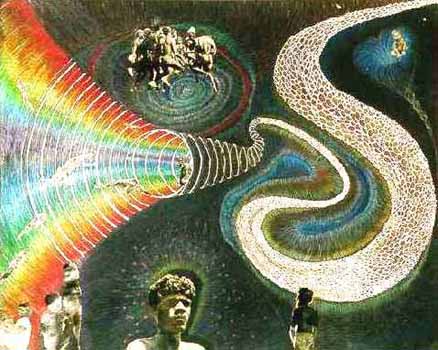
Reality is a Dream
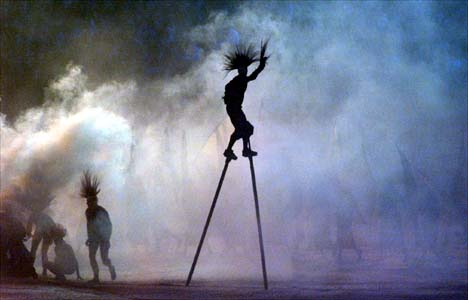
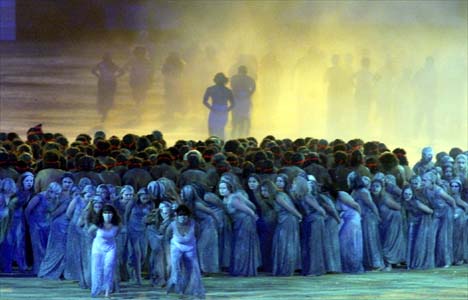
In the animist framework of Australian Aboriginal mythology, The Dreaming is a sacred era in which ancestral Totemic Spirit Beings formed The Creation.
"Dreaming" is also often used to refer to an individual's or group's set of beliefs or spirituality. For instance, an indigenous Australian might say that he or she has Kangaroo Dreaming, or Shark Dreaming, or Honey Ant Dreaming, or any combination of Dreamings pertinent to their "country". Many Indigenous Australians also refer to the Creation time as "The Dreaming". The Dreamtime laid down the patterns of life for the Aboriginal people.
Dreaming stories vary throughout Australia, with variations on the same theme. For example, the story of how the birds got their colors is different in New South Wales and in Western Australia. Stories cover many themes and topics, as there are stories about creation of sacred places, land, people, animals and plants, law and custom. It is a complex network of knowledge, faith, and practices that derive from stories of creation. It pervades and informs all spiritual and physical aspects of an indigenous Australian's life.
They believe that every person essentially exists eternally in the Dreaming. This eternal part existed before the life of the individual begins, and continues to exist when the life of the individual ends. Both before and after life, it is believed that this spirit-child exists in the Dreaming and is only initiated into life by being born through a mother.
The spirit of the child is culturally understood to enter the developing fetus during the fifth month of pregnancy.
When the mother felt the child move in the womb for the first time, it was thought that this was the work of the spirit of the land in which the mother then stood. Upon birth, the child is considered to be a special custodian of that part of his country and is taught the stories and song lines of that place. As Wolf (1994: p. 14) states: "A black 'fella' may regard his totem or the place from which his spirit came as his Dreaming. He may also regard tribal law as his Dreaming."
It was believed that, before humans, animals, and plants came into being, their 'souls' existed; they knew they would become physical, but not when. And when that time came, all but one of the 'souls' became plants or animals, with the last one becoming human and acting as a custodian or guardian to the natural world around them.
Traditional Australian indigenous peoples embrace all phenomena and life as part of a vast and complex system-reticulum of relationships which can be traced directly back to the ancestral Totemic Spirit Beings of The Dreaming. This structure of relations, including food taboos, had the result of maintaining the biological diversity of the indigenous environment. It may have helped prevent overhunting of particular species.
The Dreaming establishes the structures of society, rules for social behavior, and the ceremonies performed to ensure continuity of life and land. The Dreaming governs the laws of community, cultural lore and how people are required to behave in their communities. The condition that is The Dreaming is met when people live according to law, and live the lore: perpetuating initiations and Dreaming transmissions or lineages, singing the songs, dancing the dances, telling the stories, painting the songlines and Dreamings.
The Creation was believed to be the work of culture heroes who travelled across a formless land, creating sacred sites and significant places of interest in their travels. In this way songlines were established, some of which could travel right across Australia, through as many as six to ten different language groupings. The songs and dances of a particular songline were kept alive and frequently performed at large gatherings, organised in good seasons.
In the Aboriginal world view, every event leaves a record in the land. Everything in the natural world is a result of the actions of the archetypal beings, whose actions created the world. Whilst Europeans consider these cultural ancestors to be mythical, many Aboriginal people believe in their literal existence. The meaning and significance of particular places and creatures is wedded to their origin in the Dreaming, and certain places have a particular potency, which the Aborigines call its dreaming.
In this dreaming resides the sacredness of the earth. For example, in Perth, the Noongar believe that the Darling Scarp is said to represent the body of a Wagyl - a serpent being that meandered over the land creating rivers, waterways and lakes. It is taught that the Wagyl created the Swan River.
In another example, the Gagudju people of Arnhemland, for which Kakadu National Park is named, believe that the sandstone escarpment that dominates the park's landscape was created in the Dreamtime when Ginga (the crocodile-man) was badly burned during a ceremony and jumped into the water to save himself. He turned to stone and became the escarpment. The common theme in these examples and similar ones is that topographical features are either the physical embodiments of creator beings or are the results of their activity.
In one version (there are many Aboriginal cultures), Altjira was the god of the Dreamtime; he created the Earth and then retired as the Dreamtime vanished. Alternative names for Altjira in other Australian languages include Alchera (Arrernte), Alcheringa, Mura-mura (Dieri), and Tjukurpa (Pitjantjatjara).
The dreaming and travelling trails of the Spirit Beings are the songlines (or "Yiri" in the Warlpiri language). The signs of the Spirit Beings may be of spiritual essence, physical remains such as petrosomatoglyphs of body impressions or footprints, amongst natural and elemental simulacrae. To cite an example, people from a remote outstation called Yarralin, which is part of the Victoria River region, venerate the spirit Walujapi as the Dreaming Spirit of the black-headed python. Walujapi carved a snakelike track along a cliff-face and left an impression of her buttocks when she sat establishing camp.
Both these dreaming signs are still discernible. In the Wangga genre, the songs and dances express themes related to death and regeneration. They are performed publicly with the singer composing from their daily lives or while Dreaming of a nyuidj (dead spirit).
Many non-native writers and artists have been inspired by Dreamtime concepts for film literature and other media projects.
Australian Aboriginal Mythology
All such myths variously tell significant truths within each Aboriginal group's local landscape. They effectively layer the whole of the Australian continent's topography with cultural nuance and deeper meaning, and empower selected audiences with the accumulated wisdom and knowledge of Australian Aboriginal ancestors back to time immemorial.
Australian Aboriginal mythologies have been characterised as "at one and the same time fragments of a catechism, a liturgical manual, a history of civilization, a geography textbook, and to a much smaller extent a manual of cosmography."
There are 400 distinct Aboriginal groups across Australia, each distinguished by unique names usually identifying particular languages, dialects, or distinctive speech mannerisms. Each language was used for original myths, from which the distinctive words and names of individual myths derive.
With so many distinct Aboriginal groups, languages, beliefs and practices, scholars cannot attempt to characterise, under a single heading, the full range and diversity of all myths being variously and continuously told, developed, elaborated, performed, and experienced by group members across the entire continent. The Encyclopaedia of Aboriginal Australia nevertheless observes: "One intriguing feature of Aboriginal Australian mythology is the mixture of diversity and similarity in myths across the entire continent."
Australian anthropologists willing to generalize suggest Aboriginal myths still being performed across Australia by Aboriginal peoples serve an important social function amongst their intended audiences: justifying the received ordering of their daily lives; helping shape peoples' ideas; and assisting to influence others' behavior. In addition, such performance often continuously incorporates and "mythologies" historical events in the service of these social purposes in an otherwise rapidly changing modern world.
In Australian Aboriginal mythology, The Dreaming or Altjeringa (also called the Dreamtime) is a sacred 'once upon a time' time out of time in which ancestral Totemic Spirit Beings formed The Creation.
The Dreamtime contains many parts: It is the story of things that have happened, how the universe came to be, how human beings were created and how the Creator intended for humans to function within the cosmos.
The expression 'Dreamtime' is most often used to refer to the 'time before time', or 'the time of the creation of all things', while 'Dreaming' is often used to refer to an individual's or group's set of beliefs or spirituality.
For instance, an Indigenous Australian might say that they have Kangaroo Dreaming, or Shark Dreaming, or Honey Ant Dreaming, or any combination of Dreamings pertinent to their 'country'. However, many Indigenous Australians also refer to the creation time as 'The Dreaming'.
What is certain is that 'Ancestor Spirits' came to Earth in human and other forms and the land, the plants and animals were given their form as we know them today.
These Spirits also established relationships between groups and individuals, (whether people or animals) and where they traveled across the land, or came to a halt, they created rivers, hills, etc., and there are often stories attached to these places.
Once their work was done, the Ancestor Spirits changed again; into animals or stars or hills or other objects. For Indigenous Australians, the past is still alive and vital today and will remain so into the future. The Ancestor Spirits and their powers have not gone, they are present in the forms into which they changed at the end of the 'Dreamtime' or 'Dreaming', as the stories tell.
The stories have been handed down through the ages and are an integral part of an Indigenous person's 'Dreaming'.
Each tribe has its individual dreamtime although some of the legends overlap. Most 'Dreamtime' originates with the Giant Dog or the Giant Snake, and each is unique and colorful in its explanation.
Legends of the 'Dreamtime' are handed down by word of mouth and by totem from generation to generation. It involves secret rituals and rites, and some classified as 'Men's Business' and some as 'Women's Business'. Colorful, symbolic and enthusiastic dancing and corroborees are used to pass on the stories of the creation.
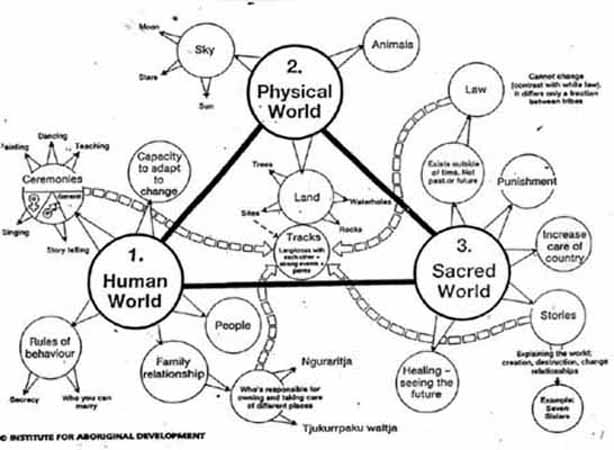
The Australian Aborigines speak of jiva or guruwari, a seed power deposited in the earth. In the Aboriginal world view, every meaningful activity, event, or life process that occurs at a particular place leaves behind a vibrational residue in the earth, as plants leave an image of themselves as seeds. The shape of the land - its mountains, rocks, riverbeds, and water holes - and its unseen vibrations echo the events that brought that place into creation. Everything in the natural world is a symbolic footprint of the metaphysical beings whose actions created our world. As with a seed, the potency of an earthly location is wedded to the memory of its origin.
The Aborigines called this potency the "Dreaming" of a place, and this Dreaming constitutes the sacredness of the earth. Only in extraordinary states of consciousness can one be aware of, or attuned to, the inner dreaming of the Earth.
"Dreaming" is also often used to refer to an individual's or group's set of beliefs or spirituality. For instance, an Indigenous Australian might say that they have Kangaroo Dreaming, or Shark Dreaming, or Honey Ant Dreaming, or any combination of Dreamings pertinent to their "country". However, many Indigenous Australians also refer to the creation time as "The Dreaming". The Dreamtime laid down the patterns of life for the Aboriginal people.
Dreaming stories vary throughout Australia, and there are different versions on the same theme. For example, the story of how the birds got their colors is different in New South Wales and in Western Australia. Stories cover many themes and topics, as there are stories about creation of sacred places, land, people, animals and plants, law and custom. It is a complex network of knowledge, faith, and practices that derive from stories of creation, and which pervades and informs all spiritual and physical aspects of an indigenous Australian's life.
They believe that every person in an essential way exists eternally in the Dreaming. This eternal part existed before the life of the individual begins, and continues to exist when the life of the individual ends. Both before and after life, it is believed that this spirit-child exists in the Dreaming and is only initiated into life by being born through a mother. The spirit of the child is culturally understood to enter the developing fetus during the 5th month of pregnancy.
When the mother felt the child move in the womb for the first time, it was thought that this was the work of the spirit of the land in which the mother then stood. Upon birth, the child is considered to be a special custodian of that part of their country and taught of the stories and songlines of that place. As Wolf (1994: p.14) states: "A black 'fella' may regard his totem or the place from which his spirit came as his Dreaming. He may also regard tribal law as his Dreaming."
It was believed that, before humans, animals, and plants came into being, their 'souls' existed by themselves; they knew they would become physical, but not when. When that time came, all but one of the 'souls' became plants or animals, with the last one becoming human and acting as a custodian or guardian to the natural world around them. Traditional Australian indigenous peoples embrace all phenomena and life as part of a vast and complex system-reticulum of relationships which can be traced directly back to the ancestral Totemic Spirit Beings of The Dreaming. This structure of relations, including food taboos, was important to the maintenance of the biological diversity of the indigenous environment and may have contributed to the prevention of overhunting of particular species.
The creation was believed to be the work of culture heroes that in the creative epoch travelled across a formless land, creating sacred sites and significant places of interest in their travels. In this way songlines were established, some of which could travel right across Australia, through as many as six to ten different language groupings. The songs and dances of a particular songline were kept alive and frequently performed at large gatherings, organised in good seasons.
In the Aboriginal world view, every event leaves a record in the land. Everything in the natural world is a result of the actions of the archetypal beings, beings whose actions created the world. Whilst Europeans consider these cultural ancestors to be magical many Aboriginal people still believe in their literal existence. The meaning and significance of particular places and creatures is wedded to their origin in the Dreaming, and certain places have a particular potency, which the Aborigines call its dreaming. In this dreaming resides the sacredness of the earth. For example in Perth, the Noongar believe that the Darling Scarp is said to represent the body of a Wagyl - a serpent being that meandered over the land creating rivers, waterways and lakes. It is taught that the Wagyl created the Swan River.
In one version (there are many Aboriginal cultures) Altjira was the god of the Dreamtime; he created the Earth and then retired as the Dreamtime vanished. Alternative names for Aktjira in other Australian languages include Alchera (Arrernte), Alcheringa, Mura-mura (Dieri), and Tjukurpa (Pitjantjatjara).
The dreaming and travelling trails of the Spirit Beings are the songlines (or "Yiri" in the Warlpiri language). The signs of the Spirit Beings may be of spiritual essence, physical remains such as petrosomatoglyphs of body impressions or footprints, amongst natural and elemental simulacrae. To cite an example, the Yarralin people of the Victoria River Valley venerate the spirit Walujapi as the Dreaming Spirit of the black-headed python. Walujapi carved a snakelike track along a cliff-face and deposited an impression of her buttocks when she sat establishing camp. Both these dreaming signs are currently discernible.

Wandjina They resemble Gray Aliens
The Wandjinas have common colors of black, red and yellow on a white background.
Wandjinas are believed to have made the sea, the earth and all its inhabitants. The existing rock art found, has depicted them as having huge upper bodies and large heads. Their faces show eyes and nose, but typically lack mouths. Around the heads of Wandjinas there appears to be lightning and feathers. The Wandjina is thought to have special powers and if offended, can cause flooding and intense lightning. The paintings are still believed to have special powers and therefore are to be approached cautiously.
Having set them in a good place, the All-Father departed.
To the first man and woman, children were born and to them in turn children who enjoyed the work of the hands of Baiame. His world had begun to be populated, and men and women praised Baiame for providing for all their needs. Sun and rain brought life to the plants that provided their sustenance.
All was well in the world they had received from the bountiful provider, until a year when the rain ceased to fall. There was little water. The flowers failed to fruit, leaves fell from the dry, withered stems, and there was hunger in the land--a new and terrifying experience for men, women, and little children who had never lacked for food and drink.
In desperation a man killed some of the forbidden animals, and shared the kangaroo-rats he had caught with his wife. They offered some of the flesh to one of their friends but, remembering Baiame's prohibition, he refused it. The man was ill with hunger. They did their best to persuade him to eat, but he remained steadfast in his refusal. At length, wearying of their importunity, he staggered to his feet, turning his back on the tempting food, and walked away.
Shrugging their shoulders, the husband and wife went on with their meal. Once they were satisfied, they thought again of their friend and wondered whether they could persuade him to eat. Taking the remains of the meal with them, they followed his trail. It led across a broad plain and disappeared at the edge of a river. They wondered how he had crossed it and, more importantly, how they themselves could cross. In spite of the fact that it had dwindled in size, owing to the prolonged drought, it was running too swiftly for them to wade or swim.
They could see him, some little distance away on the farther side, lying at the foot of a tall gum tree. They were on the point of turning back when they saw a coal-black figure, half man half beast, dropping from the branches of the tree and stooping over the man who was lying there.
They shouted a warning, but were too far away for him to hear, even if he were awake. The black monster picked up the inert body, carried it up into the branches and disappeared. They could only think that the tree trunk was hollow and that the monster had retreated to its home with his lifeless burden.
One event succeeded another with bewildering rapidity. A puff of smoke billowed from the tree. The two frightened observers heard a rending sound as the tree lifted itself from the ground, its roots snapping one by one, and soared across the river, rising as it took a course to the south. As it passed by they had a momentary glimpse of two large, glaring eyes within its shadow, and two white cockatoos with frantically flapping wings, trying to catch up with the flying tree, straining to reach the shelter of its branches.
Within minutes the tree, the cockatoos, and the glaring eyes had dwindled to a speck, far to the south, far above their heads,For the first time since creation, death had come to one of the men whom Baiame had created, for the monster within the tree trunk was Yowee, the Spirit of Death.
In the desolation of a drought-stricken world, all living things mourned because a man who was alive was now as dead as the kangaroo-rats that had been killed for food.
Baiame's intention for the men and animals he loved had been thwarted. 'The swamp oak trees sighed incessantly, the gum trees shed tears of blood, which crystalized as red gum,' wrote Roland Robinson, in relating this legend of the Kamilroi tribe in his book Wandjina. 'To this day,' he continued, 'to the tribes of that part is the Southern Cross known as "Yaraandoo"--the place of the White Gum tree--and the Pointers as "Mouyi", the white cockatoos.'
It was a sad conclusion to the hopes of a world in the making, but the bright cross of the Southern Cross is a sign to men that there is a place for them in the limitless regions of space, the home of the All-Father himself, and that beyond death lies a new creation.
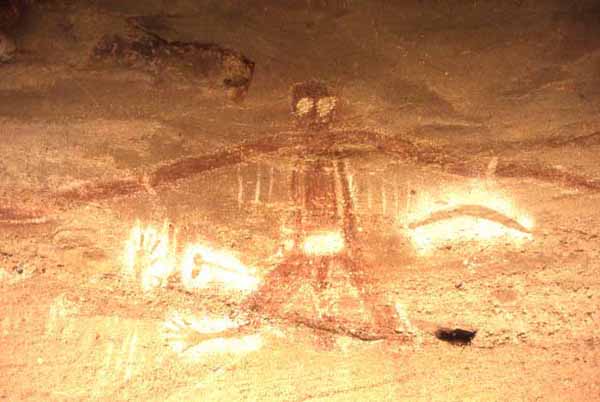 Baiame
Baiame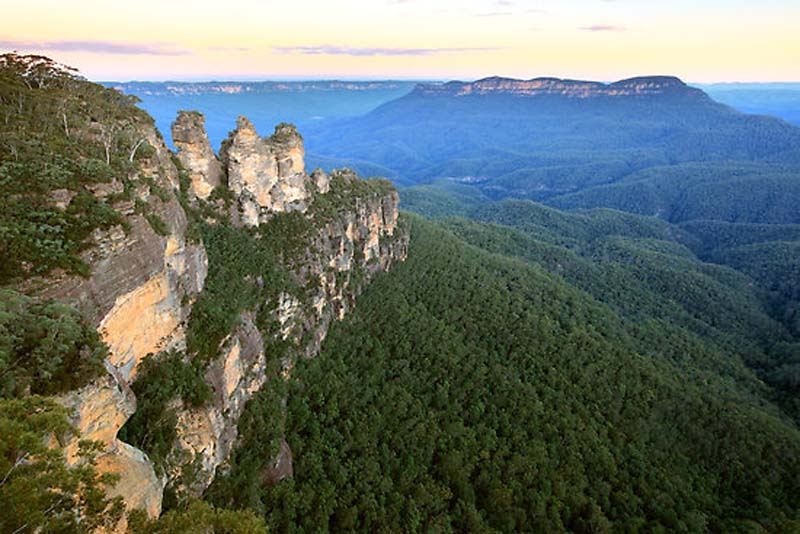
Blue Mountains
There was a time when everything was still. All the spirits of the earth were asleep - or almost all. The great Father of All Spirits was the only one awake. Gently he awoke the Sun Mother. As she opened her eyes a warm ray of light spread out towards the sleeping earth. The Father of All Spirits said to the Sun Mother, "Mother, I have work for you. Go down to the Earth and awake the sleeping spirits. Give them forms."
The Sun Mother glided down to Earth, which was bare at the time and began to walk in all directions and everywhere she walked plants grew. After returning to the field where she had begun her work the Mother rested, well pleased with herself. The Father of All Spirits came and saw her work, but instructed her to go into the caves and wake the spirits.
This time she ventured into the dark caves on the mountainsides. The bright light that radiated from her awoke the spirits and after she left insects of all kinds flew out of the caves. The Sun Mother sat down and watched the glorious sight of her insects mingling with her flowers. However once again the Father urged her on.
The Mother ventured into a very deep cave, spreading her light around her. Her heat melted the ice and the rivers and streams of the world were created. Then she created fish and small snakes, lizards and frogs. Next she awoke the spirits of the birds and animals and they burst into the sunshine in a glorious array of colors. Seeing this the Father of All Spirits was pleased with the Sun Mother's work.
She called all her creatures to her and instructed them to enjoy the wealth of the earth and to live peacefully with one another. Then she rose into the sky and became the sun.
The living creatures watched the Sun in awe as she crept across the sky, towards the west.
However when she finally sunk beneath the horizon they were panic-stricken, thinking she had deserted them. All night they stood frozen in their places, thinking that the end of time had come. After what seemed to them like a lifetime the Sun Mother peeked her head above the horizon in the East. The earth's children learned to expect her coming and going and were no longer afraid.
At first the children lived together peacefully, but eventually envy crept into their hearts. They began to argue. The Sun Mother was forced to come down from her home in the sky to mediate their bickering. She gave each creature the power to change their form to whatever they chose. However she was not pleased with the end result. The rats she had made had changed into bats; there were giant lizards and fish with blue tongues and feet. However the oddest of the new animals was an animal with a bill like a duck, teeth for chewing, a tail like a beavers and the ability to lay egg. It was called the platypus.
The Sun Mother looked down upon the Earth and thought to herself that she must create new creatures less the Father of All Spirits be angered by what she now saw. She gave birth to two children. The god was the Morning Star and the goddess was the moon. Two children were born to them and these she sent to Earth. They became our ancestors. She made them superior to the animals because they had part of her mind and would never want to change their shape.
The Sun Mother then went on a long journey; from north to south and from east to west she crossed the barren land. The earth held the seed potencies of all things, and wherever the Sun's gentle rays touched the earth, there grasses, shrubs and trees grew until the land was covered in vegetation. In each of the deep caverns in the earth, the Sun found living creatures which, like herself, had been slumbering for untold ages She stirred the insects into life in all their forms and told them to spread through the grasses and trees, then she woke the snakes, lizards, and other reptiles, and they slithered out of their deep hold.
As the snakes moved through and along the earth they formed rivers, and they themselves became creators, like the Sun. Behind the snakes mighty rivers flowed, teeming with all kinds of fish and water life. Then she called for the animals, the marsupials, and the many other creatures to awake and make their homes on the earth.
The Sun Mother then told all the creatures that the days would from time to time change from wet to dry and from cold to hot, and so she made the seasons. One day while all the animals, insects and other creatures were watching, the Sun travelled far in the sky to the west and, as the sky shone red, she sank from view and darkness spread across the land once more. The creatures were alarmed and huddled together in fear. Some time later, the sky began to glow on the horizon to the east and the Sun rose smiling into the sky again. The Sun Mother thus provided a period of rest for all her creatures by making this journey each day.
One day Dinewan the emu and Brolga the native companion were on a large plain near the Murrumbidgee. There they were, quarrelling and fighting. Brolga, in her rage, rushed to the nest of Dinewan and seized from it one of the huge eggs, which she threw with all her force up to the sky. There it broke on a heap of firewood, which burst into flame as the yellow yolk spilled all over it, and lit up the world below to the astonishment of every creature on it. They had been used to the semi-darkness and were dazzled by such brightness.
A good spirit who lived in the sky saw how bright and beautiful the earth looked when lit up by this blaze. He thought it would be a good thing to make a fire every day, and from that time he has done so. All night he and his attendant spirits collect wood and heap it up. When the heap is nearly big enough they send out the morning star to warn those on earth that the fire will soon be lit.
The spirits, however, found this warning was not sufficient, for those who slept saw it not. Then the spirits thought someone should make some noise at dawn to herald the coming of the sun and waken the sleepers. But for a long time they could not decide to whom should be given this office.
At last one evening they heard the laughter of Goo-goor-gaga, the laughing jackass, ringing through the air. "That is the noise we want," they said.
Then they told Goo-goor-gaga that, as the morning star faded and the day dawned, he was every morning to laugh his loudest, that his laughter might awaken all sleepers before sunrise. If he would not agree to do this, then no more would they light the sun-fire, but let the earth be ever in twilight again.
But Goo-goor-gaga saved the light for the world.
He agreed to laugh his loudest at every dawn of every day, and so he has done ever since, making the air ring with his loud cackling, "Goo goor gaga, goo goor gaga, goo goor gaga."
When the spirits first light the fire it does not throw out much heat. But by the middle of the day, when the whole heap of firewood is in a blaze, the heat is fierce. After that it begins to die gradually away until, at sunset, only red embers are left. They quickly die out, except a few the spirits cover up with clouds and save to light the heap of wood they get ready for the next day.
Children are not allowed to imitate the laughter of Goo-goor-gaga, lest he should hear them and cease his morning cry.
If children do laugh as he does, an extra tooth grows above their eye-tooth, so that they carry the mark of their mockery in punishment for it. Well the good spirits know that if ever a time comes when the Goo-goor-gagas cease laughing to herald the sun, then no more dawns will be seen in the land, and darkness will reign once more.
Urdlu the kangaroo and Mandya the euro dug for tucker in separate holes. Urdlu found a lot of tucker, but Mandya found only a little. Urdlu, however, wouldn't tell Mandya where his hole was. Poor Mandya was getting thinner and thinner and Urdlu was getting fatter and fatter. In the end Mandya came to Urdlu and said: "Give me some of your mai" (mai is tucker). Urdlu said to Mandya: "There's some mai in that bag there. You can take that." As he ate it, Mandya said, "This is really good tucker! Where did you get it?" Urdlu said with a wave of his arm, "Oh, I found it over there."
The pair of them went to sleep. In the morning Urdlu got up and went to look for water. While he went around looking here and there for water to drink, Mandya got up and went to find the hole where Urdlu got his tucker. He picked up Urdlu's tracks and followed them. He went along steadily down the track made by the kangaroo until he came to his hole. He dug out a big heap of tucker from it. He was so pleased he stayed there digging and eating without even looking up.
Urdlu came back from having a drink. "Now where on earth has the old fellow got to? I know, he's gone to my hole!" He took off after Mandya. He tracked him. His fresh tracks were there, all the way down to the hole. He could see where Mandya had dug up the dirt as he went along. He sure had dug up the dirt! When Urdlu arrived at the hole Mandya was so busy digging he didn't even see Urdlu coming. Mandya was digging like mad. Urdlu called out, "Why did you come to my hole?" Mandya said he was starving and Urdlu was mean not to tell him where there was tucker. He just went on eating. Now this made Urdlu really angry, so the pair of them were soon having a big fight, all over tucker. Mandya pulled at Urdlu's arms. He stretched his arms, he stretched his fingers, he stretched his legs. They got very long. Then Urdlu pressed Mandya's fingers and his legs; he pressed his back, his chest; he thrashed him. Then they separated.
The wounded Mandya went off to Vadaardlanha to camp. While he was lying there trying to go to sleep, his hip started to hurt. In fact, he had a sore. He reached down and took out a little stone from the sore. He blew on it and in a flash hills came up from the plain. Indeed, several ranges of hills came up. The more Mandya blew, the more hills kept coming up.
Meanwhile Urdlu headed down towards Varaarta (Baratta). He moved that big flat (plain) along as he went. He was lying out there on the flat when he looked back and saw the hills coming down the plain. He said, "Hey! What's the old fellow up to? Over that way there's a big range of hills coming up! If he keeps that up I won't have anywhere to live!" So, with a big sweep of his tail Urdlu pushed the ranges back to where they are now. You can see where this happened, up there north of Vardna-wartathinha. That big flat never gets any grass on it. It's called Urdlurunha-vitana (kangaroo's flat).
Urdlu then made Munda (Lake Frome) so that he would have a permanent supply of water, but Mandya was jealous about this and put salt in it. Right to the present day kangaroos cannot drink from this lake because of the salt.
Mandya was up there in the hills behind Vadaardlanha. From there he looked back and said, "Look at the way the old fellow moved that big plain along!" And as Mandya looked back he turned into a spirit. He is called Thudupinha, and you can see him sitting up there today. Below him the ground is red where his wounds bled after his big fight with Urdlu. This place is called Mandya Arti (which means Mandya's blood).
This comment has been removed by the author.
ReplyDelete